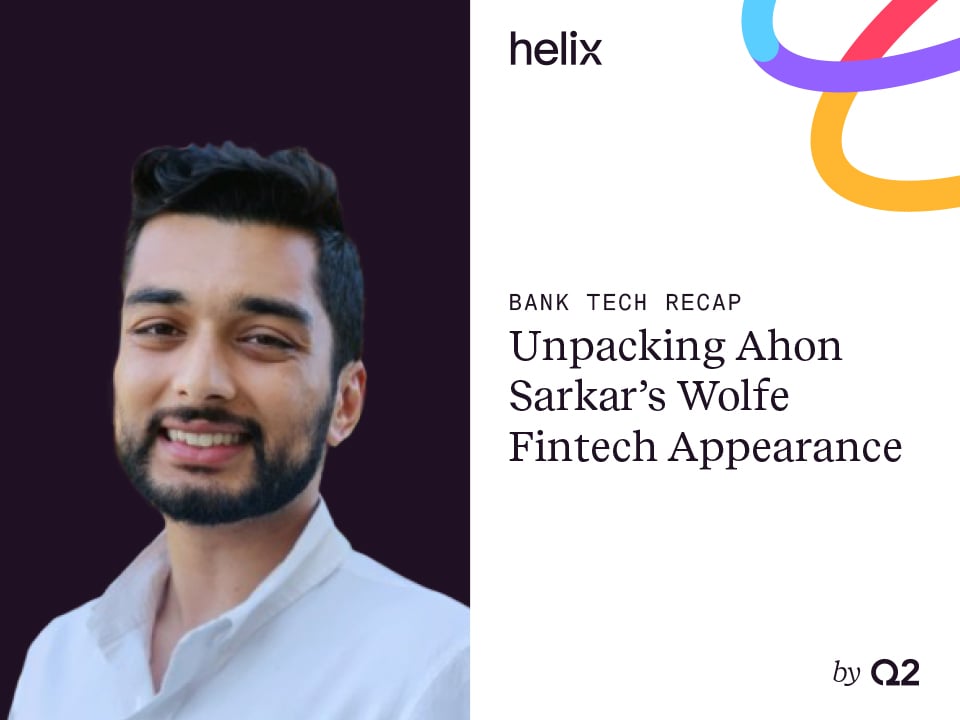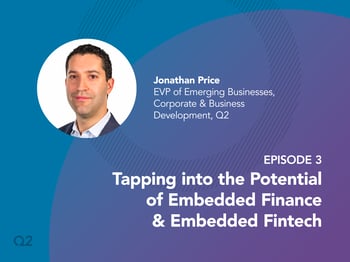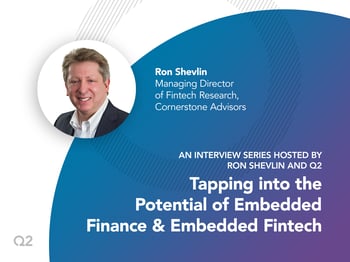Embedded finance has taken a turn toward the personal, and Ahon Sarkar, GM of Helix by Q2, spoke at Wolfe Fintech Forum about how this change is going to revolutionize the user experience. In this blog, we take snippets of Ahon’s appearance and provide more details about the points he makes. First, here's the full video:
Now let's look at a few key quotes and analyze them further.
"Banking as a service is exposing the building blocks of banking via API to allow companies to embed banking functionality inside of their businesses in partnership with banks, with credit unions, and other financial institutions."
For Helix, the building blocks of banking are accounts, cards, data and controls, risk management, admin tools, program management, and monetization solutions. Together, these fundamental components come together with your existing suite of products to create a brand-new solution — differentiated and personalized for each and every user.
"With Helix, we ask the question of what is missing for people who are looking to offer these programs at scale. And what we learned was that the biggest thing that was missing was personalization."
Attracting users is a must, but once you have them, keeping them around requires a completely different strategy. You have to get to know each and every user as an individual, and then leverage that knowledge to provide outsized value. Thinking about the building blocks of banking, this element of embedded finance leans heavily on data. You need to learn about your user — ideally both in real-time and through batch processing — and then apply that information by creating an experience designed for that specific user.
"What we've done with our platform is really take every facet of the product, from your limits and controls, to the interest that you earn, to the rewards that you can get, to the hooks that you're offered, and allow you to configure those at the user level. So these companies can take the context they have about you and build a product that's specific for you, so that you're more likely to engage. And so that in the long term, they're able to retain their customers because they've built that type of relationship."
Think about this: If you've used a platform for four years, successfully paying back what you owe every time, shouldn't that platform trust you more? And give you greater limits? But wait, you say, my credit score is low — or nonexistent! We at Helix think that should only be one part of the equation. The platform should be able to use its own data to augment your credit score and better understand your actual risk. With granular data and user-level controls, you can create personalized experiences around each user.
"I think what you're seeing is that consumer expectations are starting to change — a combination of these types of platforms being made available, [as well as] the pandemic forcing us all to live in our homes and use our phones to access banking."
Digitalization summarizes the effect of the pandemic. Remote work, remote banking, remote movies. That means the competition for our digital attention has become remarkable, and in order for your banking product to keep someone's attention, it has to offer the same top-shelf experience that Netflix does — except with the added pressure of managing a person's money. That's a tall order. But the technology now exists to offer a trustworthy, engaging, fully digital experience in the banking space.
"When a consumer looks at a brand new offering, the first question they're going to ask is why should I use this? Why should I switch? And if you don't have a discreet value proposition to that type of consumer, you're going to struggle because they have alternative options."
Switching has a cost, and especially in the financial space, also a huge burden associated with it. If your product isn't unique, it isn't going to garner the attention required to be successful. How do you make a product unique? It's an overused word, but synergy. Synergy between your existing products and your new banking products. One has to enhance the other to create something that's greater than the sum of its parts.
It also helps to have solutions available that reduce the friction of switching to your platform. At Helix, we call these Monetization Solutions. They use automation to make things like direct deposit switching or adding your user's new debit card (your debit card) to the user's various streaming services a cinch.
"If you look at the partnership that we had with Gusto, which is one of the leading payroll providers for small businesses across the United States, Gusto was able to use Helix to launch Gusto Wallet and combine it with Gusto Cash Out, which now lets any employee that has Gusto Wallet get a free cash advance from their paycheck."
Payday lenders are predatory. According to the Pew Charitable Trusts, payday loan users spend $520 in fees to borrow $375. That's unacceptable. Helix empowered Gusto to create a one-of-a-kind solution that replaces payday lenders. By combining their existing suite of solutions — payroll functionality — with embedded finance, Gusto was able to create a product that was near impossible for others to replicate.
"So I think what you'll see as banking as a service continues to expand is you'll see this move into non-financial verticals. You'll see this go into gaming, into retail, into marketplaces, into the gig economy. And what you'll realize is that all of these businesses in some way, shape, or form rely on storing money and moving money."
Because they rely on storing and moving money, these businesses will benefit from having a cash management product like embedded finance. Instead of transacting from an outside account, users will reap rewards — like discounts and higher credit limits — from moving the locus of their financial activity to the companies with whom they engage most.
"Google, Facebook, Apple, Netflix, TikTok, YouTube. When you think about the types of media and content or the types of tools that this generation consumes, every single piece of those technology companies uses the context they learn about the user to better target advertisements, to better target product hooks, to show you the shows that you actually want to watch. But as I mentioned, banking, historically, hasn't been that way. And so when consumers now come to brand new financial institutions or come to non-financial institutions, they want something that is as easy to use as the tech apps that are on their phone. They want something that takes something onerous and makes it fun, which may seem strange, but is what a lot of these companies are doing, but most importantly, they want something that actually understands them and doesn't give them things that are irrelevant."
Irrelevance kills engagement. Your app must predict the needs of its users and supply them with the most pressing content at each and every moment. You choose Netflix on your TV or computer because it reliably gives you content that you're interested in. Your embedded finance products should do the same.
"Handling fraud responsibly is the difference between a profitable program and an unprofitable program. And so one of the big things that we invest in is how do we enable not just access to fraud tooling, but also a deeper granularity in fraud management so that I can treat my good customer and my bad customers differently based off of the context that I have about them, instead of just applying broad based-rules that might actually hurt some of the people that I want to bring money into."
We offer the tools and expertise you need to mitigate risk, automate disputes, flag fraud, and understand trends that will allow you to stay one step ahead of fraudsters. Ahon mentioned “deeper granularity” — what that means is you can manage fraud yourself, or we can manage it for you using best-in-class fraud rule writing applications with proactive monitoring for new and emerging fraud trends. If you want to manage it yourself, you can set up card controls and in-authorization flow controls to provide a differentiated transaction experience for users based on customizable parameters.
We hope this deeper dive provided some of the details you need to launch a successful embedded finance program. But there’s a lot more to learn! Head on over to helix.Q2.com to explore more resources and reach out if you have further questions.





